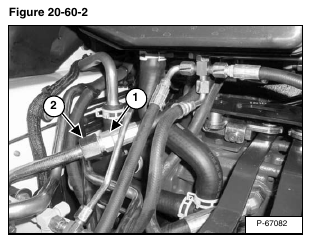The tools listed will be needed to do the following procedure:
MEL1563 or 6689779 – Remote Start Tool
MEL10103 – Hydraulic Tester
MEL10106 – Hydraulic Test Kit
Lift and block the loader. (See Procedure on Page 10-10-1.)
Raise the lift arms and install an approved lift arm support device. (See Installing on Page 10-20-1.)
Raise the operator cab. (See Raising on Page 10-30-2.)
Open the rear door of the loader.
Connect the remote start tool. (See REMOTE START TOOL KIT-MEL1563 on Page 10-60-1.)
Disconnect the OUTLET hose (Item 1) [Figure 20-60-2] that comes from the gear pump, and connects to the tubeline on the control valve.
Connect the INLET hose (Item 1) [Figure 20-60-3] from the tester to the OUTLET hose (Item 1) [Figure 20-60-2] of the pump. Connect the OUTLET hose (Item 2) [Figure 20-60-3] from the tester to the tubeline (Item 2) [Figure 20-60-2] on the control valve.
Sample tester connection shown [Figure 20-60-4].
Start the engine and run at low idle RPM. Make sure the tester is connected correctly. If no flow is indicated on the tester, the hoses are connected wrong. With the hoses connected correctly, increase the engine speed to full RPM*.
Warm the fluid to 140° F (60° C) by turning the restrictor control (Item 1) [Figure 20-60-4] on the tester to about 1000 PSI (6895 bar). DO NOT exceed system relief pressure. Open the restrictor control and record the free flow (GPM) at full RPM*.
Push the maximum/variable flow switch (on the remote start tool) to engage the front auxiliary hydraulics, the light will come ON. Push the button (on the right control lever) for fluid flow to the quick coupler (fluid pressure will go over main relief). Record the highest pressure (PSI) and flow (GPM). The high pressure flow must be at least 80% of free flow.
A low percentage may indicate a failed pump.
*Refer to (See Hydraulic System on Page SPEC-10-3.) for system relief pressure and full RPM.


